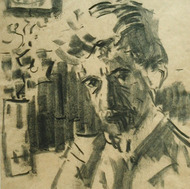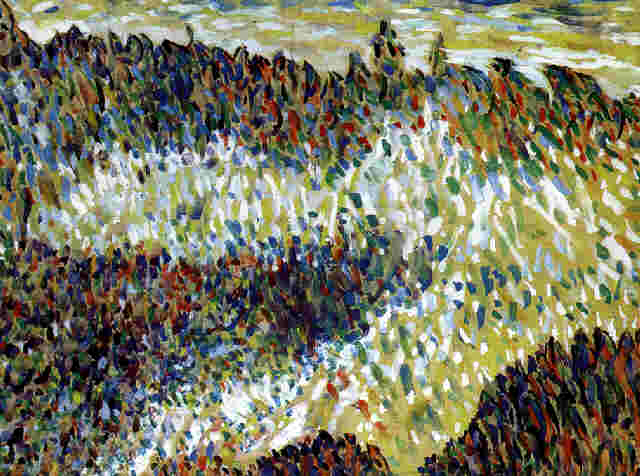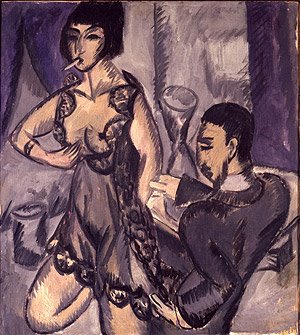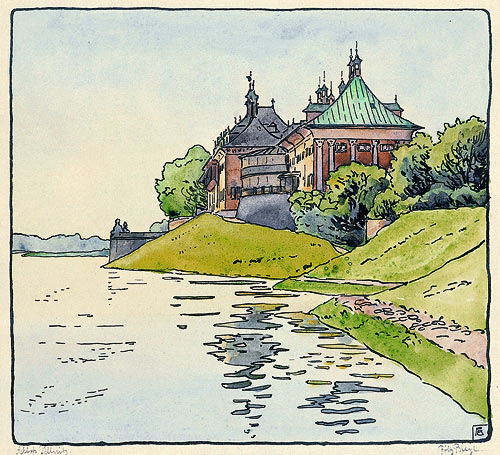<Back to Index>
- Painter and Designer Hilmar Friedrich Wilhelm "Fritz" Bleyl, 1880
PAGE SPONSOR

Hilmar Friedrich Wilhelm Bleyl, known as Fritz Bleyl, (8 October 1880, Zwickau, Kingdom of Saxony – 19 August 1966, Bad Iburg) was a German artist of the Expressionist school, and one of the four founders of artist group Die Brücke ("The Bridge"). He designed graphics for the group including, for their first show, a poster, which was banned by the police. He left the group after only two years, when he married, to look after his family, and did not exhibit publicly thereafter.
Fritz Bleyl was born in Zwickau and grew up in the Erzgebirge region. In 1901 he began studying architecture at the Königliche Technische Hochschule (technical university) of Dresden, as his parents wished; however, his own desire was to become a painter. The institution provided a wide range of studies in addition to architecture, such as freehand drawing, perspective drawing and the historical study of art.
Bleyl became close friends with fellow student, Ernst Ludwig Kirchner, whom he met during the first term. They discussed art together and also studied nature, having a radical outlook in common.
In 1905, Bleyl along with Ernst Ludwig Kirchner, and two other architecture students, Karl Schmidt - Rottluff and Erich Heckel, founded the artists group Die Brücke ("The Bridge"). The group aimed to eschew the prevalent traditional academic style and find a new mode of artistic expression, which would form a bridge (hence the name) between the past and the present. They responded both to past artists such as Albrecht Dürer, Matthias Grünewald and Lucas Cranach the Elder, as well as contemporary international avant garde movements. Their group was one of the seminal ones, which in due course had a major impact on the evolution of modern art in the 20th century and created the style of Expressionism. At this time, Bleyl was a keen member of the group. This met initially in Kirchner's first studio, which had previously been a butcher's shop. Bleyl described it as:
- that of a real bohemian, full of paintings lying all over the place, drawings, books and artist’s materials — much more like an artist’s romantic lodgings than the home of a well - organised architecture student.
Kirchner's studio lived up to Bleyl's description, becoming a venue which overthrew social conventions to allow casual love making and frequent nudity. Group life drawing sessions took place using models from the social circle, rather than professionals, and choosing quarter hour poses to encourage spontaneity. Bleyl described one such model, Isabella, a fifteen year old girl from the neighborhood, as "a very lively, beautifully built, joyous individual, without any deformation caused by the silly fashion of the corset and completely suitable to our artistic demands, especially in the blossoming condition of her girlish buds."
The group composed a manifesto (mostly Kirchner's work), which was carved on wood and asserted a new generation, "who want freedom in our work and in our lives, independence from older, established forces."
As part of the affirmation of their national heritage, they revived older media, particularly woodcut prints. Bleyl specialized in graphic design and created several significant posters and tickets presenting the group to the general public.
In September and October 1906, the first group exhibition was held, focused on the female nude, in the showroom of K.F.M. Seifert and Co. in Dresden. Deriving from the life studies, Bleyl created a lithographic poster for the show printed in orange ink on white paper. It has a narrow, portrait format, more akin to Japanese woodcuts than conventional contemporary prints, and was a distinct contrast to the poster designed by Otto Gussmann for the Third German Exhibition of Applied Arts, which had opened four months previously in Dresden. Bleyl omits iconography such as a crown, a lamp and a flowing gown, to show a bold nude of the model Isabella full length above the lettering. Police censors barred the display of the poster under Paragraph 184, the National Penal Code pornography clause, after perceiving pubic hair in the shadow underneath the stomach.
In 1905, Bleyl completed his university studies and, the following year, began to teach at the Bauschule (school of architecture) in Freiberg, Saxony. He chose a bourgeois lifestyle, marrying in 1907 and, with a concern to support his family, left the group. He was replaced by Max Pechstein and Otto Mueller.
In 1916, he completed his dissertation, and traveled in Italy and through the Alps. For the rest of his life, he continued to teach and to practice as an architect. He also continued with graphic work, but kept out of public gaze and did not have exhibitions. He resided in Rostock, Neukölln in Berlin, and Brandenburg.



